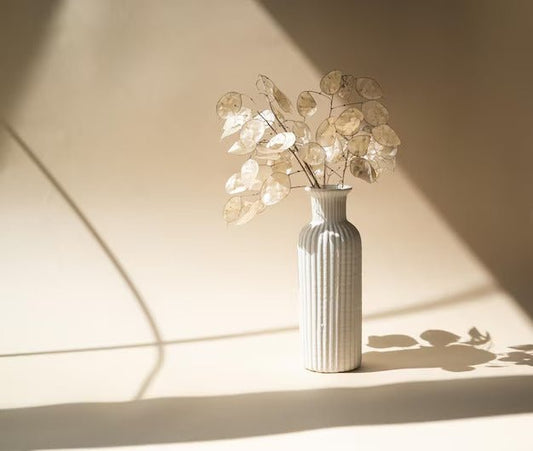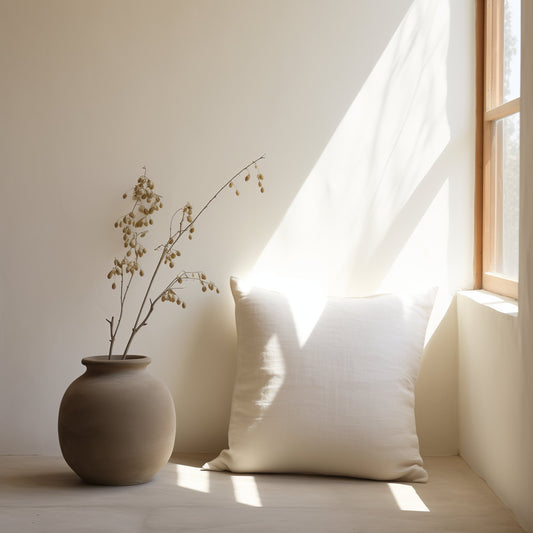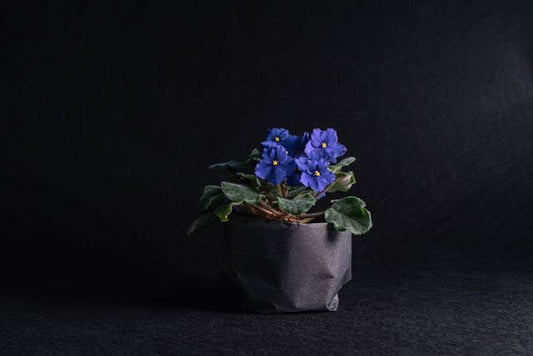In the pursuit of a serene and elegant home aesthetic, many are turning to the Japanese concept of wabi-sabi. This philosophy embraces imperfection, transience, and the beauty of natural aging. Incorporating carefully chosen foliage accessories can significantly enhance this look, bringing a touch of nature's imperfect beauty into your living spaces. Here are five plant-based elements that can help you achieve that sophisticated, well-curated wabi-sabi ambiance.
1. Dried Pampas Grass
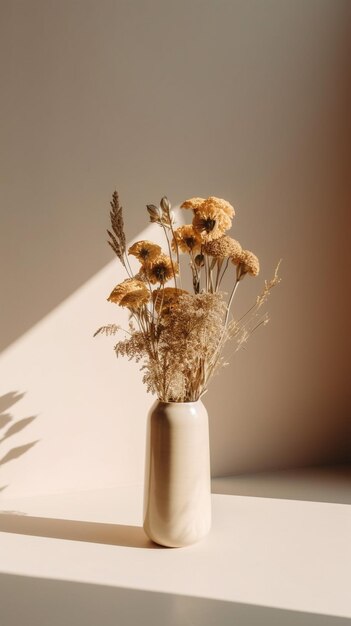
Pampas grass, with its feathery plumes, adds a soft, textural element to any space. These tall, graceful stems boast fluffy, cream-colored or pale pink inflorescences that seem to capture the essence of a gentle breeze. The delicate nature of pampas grass belies its durability as a dried arrangement, making it an ideal choice for long-lasting wabi-sabi decor.
Description: Pampas grass typically stands between 1.5 to 3 feet tall when dried and arranged. Its plumes are wide and feathery, creating a soft, cloud-like appearance. The stems are sturdy and straight, providing a nice contrast to the ethereal tops. Colors range from ivory and beige to soft pink and even dyed varieties, though natural hues are more in keeping with the wabi-sabi aesthetic.
Procurement: Available at florists, craft stores, or online retailers. When purchasing, look for full, undamaged plumes and avoid overly processed or bleached varieties.
Treatment: Minimal treatment required. Gently fluff the plumes upon arrival to restore their volume after shipping.
Maintenance: Dust occasionally with a soft, dry cloth or use a hair dryer on cool setting to maintain its fluffy appearance. Avoid placing in high-humidity areas to prevent mold.
Wabi-Sabi Appeal: The natural variations in color and texture of pampas grass embody the wabi-sabi appreciation for imperfection. As it ages, it may shed slightly, creating an ever-evolving display.
Elevation Tip: Arrange in a simple, weathered ceramic vase for added wabi-sabi charm. Consider mixing different heights of pampas grass for a more dynamic display.
2. Preserved Eucalyptus
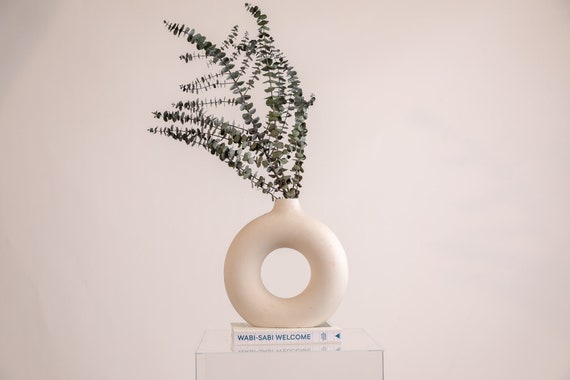
The muted green-gray tones of preserved eucalyptus bring a calming presence to any room. This versatile foliage offers a range of shapes and sizes, from the round leaves of silver dollar eucalyptus to the elongated leaves of willow eucalyptus.
Description: Preserved eucalyptus retains the plant's natural structure and subtle coloration. Leaves are typically oval or elongated, arranged along flexible stems. The color palette ranges from soft sage greens to blue-grays, sometimes with a subtle frosted appearance. Stems can vary in length but are often between 18 to 30 inches, allowing for versatile arrangements.
Procurement: Available at florists or specialty home decor stores. When selecting, look for branches with intact leaves and avoid any with obvious discoloration or brittleness.
Treatment: No treatment necessary; comes ready to display. However, handle gently to avoid dislodging leaves.
Maintenance: Keep away from direct sunlight to preserve color. No watering required. Occasionally dust with a soft, dry cloth if needed.
Wabi-Sabi Appeal: As it slowly dries further, eucalyptus changes color, embracing the wabi-sabi concept of transience. The gradual curling of leaves over time adds to its evolving beauty.
Elevation Tip: Mix different eucalyptus varieties for a more complex, layered look. Consider pairing with other dried elements like seed pods or grasses for textural contrast.
3. Branch of Japanese Maple
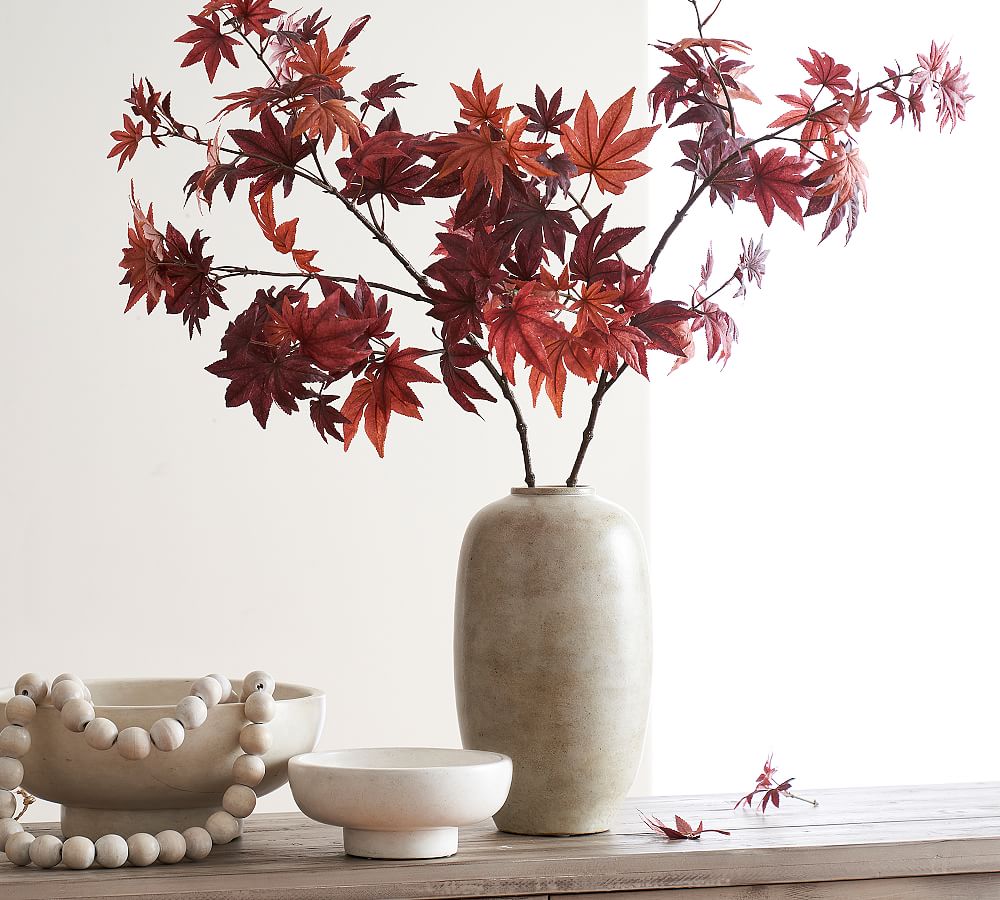
A single branch of Japanese maple can serve as a striking focal point, bringing the elegance of nature's architecture into your space. The delicate leaves and graceful branching structure of Japanese maple perfectly embody the refined simplicity prized in wabi-sabi aesthetics.
Description: Japanese maple branches feature palmately lobed leaves, typically with five to nine pointed lobes. The leaves are arranged oppositely on slender, often reddish-brown stems. When dried, the leaves can take on rich hues ranging from deep burgundy to golden amber, depending on the variety and drying process. Branches usually measure between 18 to 36 inches in length.
Procurement: Forage from your garden or purchase from a specialty florist. If foraging, choose branches with interesting shapes and ensure you're cutting during the appropriate season for the best color retention.
Treatment: Allow to dry naturally by hanging upside down in a cool, dry place for about two weeks. This preserves the leaf shape and color as much as possible.
Maintenance: Once dried, handle gently to prevent leaf loss. Store away from direct sunlight to maintain color vibrancy.
Wabi-Sabi Appeal: The intricate structure and changing colors of the leaves perfectly capture wabi-sabi's appreciation for nature's cycles. The potential for leaves to gradually fall over time adds to its wabi-sabi charm.
Elevation Tip: Display against a light-colored wall to highlight its delicate structure. Consider arranging in a shallow, unglazed ceramic dish for a harmonious wabi-sabi presentation.
4. Dried Lotus Pods

These unique sculptural elements add interest and depth to arrangements. Lotus pods bring an organic, almost otherworldly quality to your decor, their intricate patterns and earthy tones perfectly aligning with wabi-sabi principles.
Description: Dried lotus pods are the seed heads of the lotus flower. They are roughly circular, measuring about 3 to 5 inches in diameter. The surface is covered with numerous holes where the seeds once sat, creating a distinctive honeycomb-like pattern. The color is typically a warm brown, sometimes with hints of green or black.
Procurement: Available from craft stores, florists, or online suppliers. Look for pods that are intact and free from mold or discoloration.
Treatment: No treatment necessary if purchased dried. If you've harvested them fresh, allow them to air dry completely before use.
Maintenance: Dust gently with a soft brush to maintain their intricate texture. Avoid exposure to moisture, which can cause mold.
Wabi-Sabi Appeal: The rough texture and earthy tones of lotus pods embody wabi-sabi's celebration of natural materials. Their unique form serves as a reminder of nature's diverse beauty.
Elevation Tip: Combine with softer elements like dried grasses for textural contrast. Display in a weathered wooden bowl or on a piece of driftwood for an enhanced wabi-sabi effect.
5. Dried Lunaria

Dried lunaria, also known as the "money plant" or "honesty plant," brings a delicate, ethereal quality to wabi-sabi-inspired decor. Its translucent, disc-shaped seed pods add a unique textural element and subtle shimmer to arrangements.
Description: Lunaria features slender stems adorned with round, flat seed pods. These pods start green but dry to a translucent silvery-white, resembling delicate paper or mother-of-pearl. Each pod is typically about 1-2 inches in diameter. The stems can reach 1-3 feet in height, often branching to create an airy, architectural form.
Procurement: Available from florists, craft stores, or online suppliers specializing in dried flowers. You can also grow and dry your own if you have a garden. When purchasing, look for stems with intact pods and minimal discoloration.
Treatment: If drying your own, cut the stems when the seed pods have turned from green to a papery brown. Hang them upside down in a dry, dark place for about two weeks. Once dry, gently remove the outer layers of the pods to reveal the translucent centers.
Maintenance: Handle with care as the pods can be fragile. Dust very gently with a soft, dry brush if needed. Keep away from moisture and direct sunlight to preserve their delicate structure and color.
Wabi-Sabi Appeal: The fragile nature of dried lunaria perfectly embodies the wabi-sabi appreciation for impermanence. As the pods age, they may become more brittle or lose their sheen, creating an ever-evolving display that celebrates the beauty of natural aging.
Elevation Tip: Arrange lunaria stems in a simple, narrow-necked vase to showcase their unique form. For a striking contrast, pair them with darker elements like dried seedheads or branches. The interplay of light through the translucent pods can create beautiful shadows, adding depth to your wabi-sabi-inspired space.
Conclusion
Incorporating these foliage accessories into your decor can significantly enhance the wabi-sabi aesthetic of your space. Each element brings its own unique texture, color, and form, contributing to a rich, layered environment that celebrates the beauty of nature's imperfections.
Remember, the key to wabi-sabi is embracing imperfection and the natural aging process. Allow these elements to change over time, appreciating the unique beauty in each stage of their existence. The dried pampas grass may shed, the eucalyptus might curl, the Japanese maple leaves could drop, the lotus pods may darken, and the bamboo might develop subtle cracks – all of these changes are part of the wabi-sabi journey.
By thoughtfully selecting and arranging these natural elements, you can create a sophisticated, well-curated environment that embodies the serene elegance of wabi-sabi. This approach to decor not only beautifies your space but also serves as a gentle reminder of the transient nature of beauty and the value of embracing life's natural cycles.
As you incorporate these elements into your home, take time to observe how they interact with light, shadow, and the changing seasons. This mindful approach to decorating aligns perfectly with the wabi-sabi philosophy, encouraging a deeper appreciation for the subtle beauty that surrounds us every day.

